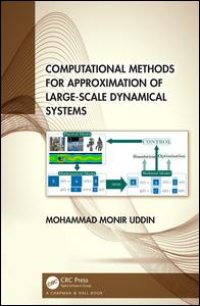
Ebook: Computational Methods for Approximation of Large-Scale Dynamical Systems
Author: Mohammad Monir Uddin (Author)
- Tags: Computer Science, Computation, Computer Science (General), Engineering & Technology, Electrical & Electronic Engineering, Systems & Controls, Mathematics & Statistics, Advanced Mathematics, Applied Mathematics, Mathematical Modeling
- Year: 2019
- Publisher: Chapman and Hall/CRC
- City: New York
- Edition: 1
- pdf
These days, computer-based simulation is considered the quintessential approach to exploring new ideas in the different disciplines of science, engineering and technology (SET). To perform simulations, a physical system needs to be modeled using mathematics; these models are often represented by linear time-invariant (LTI) continuous-time (CT) systems. Oftentimes these systems are subject to additional algebraic constraints, leading to first- or second-order differential-algebraic equations (DAEs), otherwise known as descriptor systems. Such large-scale systems generally lead to massive memory requirements and enormous computational complexity, thus restricting frequent simulations, which are required by many applications. To resolve these complexities, the higher-dimensional system may be approximated by a substantially lower-dimensional one through model order reduction (MOR) techniques. Computational Methods for Approximation of Large-Scale Dynamical Systems discusses computational techniques for the MOR of large-scale sparse LTI CT systems. Although the book puts emphasis on the MOR of descriptor systems, it begins by showing and comparing the various MOR techniques for standard systems.
The book also discusses the low-rank alternating direction implicit (LR-ADI) iteration and the issues related to solving the Lyapunov equation of large-scale sparse LTI systems to compute the low-rank Gramian factors, which are important components for implementing the Gramian-based MOR.
Although this book is primarly aimed at post-graduate students and researchers of the various SET disciplines, the basic contents of this book can be supplemental to the advanced bachelor`s-level students as well. It can also serve as an invaluable reference to researchers working in academics and industries alike.
Features:
- Provides an up-to-date, step-by-step guide for its readers. Each chapter develops theories and provides necessary algorithms, worked examples, numerical experiments and related exercises. With the combination of this book and its supplementary materials, the reader gains a sound understanding of the topic.
- The MATLAB® codes for some selected algorithms are provided in the book. The solutions to the exercise problems, experiment data sets and a digital copy of the software are provided on the book`s website;
- The numerical experiments use real-world data sets obtained from industries and research institutes.